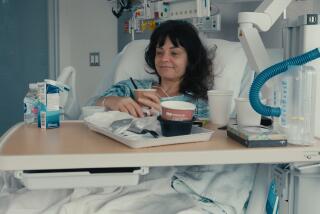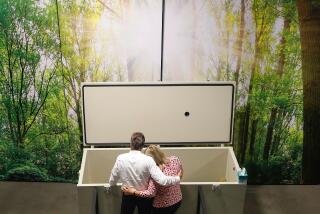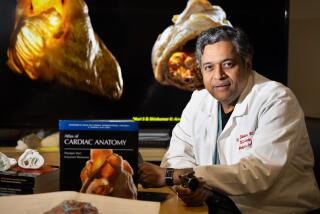A cadaver gets under her skin
We enter the gross anatomy lab at 8 a.m. and spend the next two-and-a-half hours palpating bodies, cutting through skin and subcutaneous fat, probing muscle layers and searching for nerves and blood vessels.
Before our first day, our anatomy professor spoke briefly about the special — and privileged — experience that lay ahead. “You will remember where you were standing,” she said. “You will remember the first cut.”
That cut was not our first interaction with the cadavers. Nor was it the most memorable.
We were supposed to start with the back — a relatively impersonal region with thick, well-defined muscles. But after we unzipped our body bag, we saw that our cadaver wasn’t lying on its stomach. We would have to flip it.
For several minutes, my lab mates and I struggled to lift the heavy man — literally dead weight, and filled with gallons of embalming fluid — and turn him onto his stomach. I grabbed his left arm and leg to steady the body, and I felt slightly sick. Physically manipulating a dead body turned out to be much more jarring than making restrained surgical incisions through his skin.
It took me a few sessions before I could hold the scalpel and forceps correctly. Grudgingly, I learned to wield the dissecting scissors more like a surgeon (fourth finger in the hole) and less like a kindergartener.
What I discovered throughout lab was that the worst, most disturbing moments were the most familiar ones. To position the arm for cutting, I had to twist it carefully. The elbow joint still worked and the flexion resembled a living person’s, not the stiff limb I had imagined. Brushing against the man’s fingernails — grime still underneath them — was unpleasant in its familiarity. Seeing toughened skin and hair on the man’s arms and legs gave me the same unnerving feeling.
It was the new and unrecognizable that unsettled me least. Human muscle and its surrounding fascia fascinated me. Pulling on a certain muscle in the forearm to move the cadaver’s thumb felt like operating a surreal version of a marionette. Rolling up the skin and subcutaneous fat like a carpet after we had cut it away was too far removed from reality to make me shudder.
In these six weeks, I have learned that our bodies can differ substantially, with apparently no impact. There are certain things we’ll never know about ourselves unless a careful anatomist dissects us. Some arteries, veins and nerves follow paths that differ substantially from what’s shown in textbooks. Sometimes, they simply do not exist. In some people, the right kidney is higher; in others, the left is. A thigh can have a large benign mass, made entirely of fat. Cysts are very common, sprinkled throughout the body.
I learned that the body is almost entirely shades of brown, yellow, gray and red. The gallbladder and its contents are the only exception: a stunning bright olive green. In living people, it is robin’s egg blue.
Our instructors talked quite a bit beforehand about how to maintain “respect” for the cadavers. We were told not to give them names — they already have names, we just don’t know them. We were told nothing of their ages or causes of death. (There are many arguments about whether this dehumanizes the cadavers or protects their status and anonymity.)
When we palpated the gluteal muscles, feces emerged from the cadaver’s anus. Should I feel embarrassed that I was thoroughly disgusted? I certainly would feel about the same way about a living person, and I’m not ashamed to admit it. Is it really any more respectful, then, to hide a feeling of disgust when the subject happens to be dead?
I was horrified the first time I held the cadaver’s cold hand for an extended period of time. It was inhuman. This visceral reaction against death doesn’t strike me as particularly disrespectful either.
I had been fairly certain that the experience would feel laden with emotion and that I wouldn’t be comfortable if my lab mates treated the situation with anything other than intense seriousness. But I quickly realized that “respect” didn’t stem from how we felt or what we said. It came from our deeper attitude toward the task at hand.
Intimate anonymity
One night, alone in the anatomy lab, I was reviewing our cadaver’s abdominal and pelvic organs. I knew that the next time I saw him, I would be dissecting his face and neck. There would be little time for reflection. I lifted the sheet that had covered his face for the last month.
Our guy was entirely dissected, in some places far less than perfectly. During lab, I no longer mused about the now bloated, skinless hand while I was wrist-deep in intestines and embalming fluid. I no longer thought about “the person” or “the patient” while I cursed the smell — a mixture of embalming fluid and bodily contents, particularly when we dissected near the rectum.
It is amazing what a difference a face makes. I looked at it, completely intact, feeling a combination of awe and shame. His eyes weren’t completely closed. His nostrils flared a bit. He had strong, gray stubble.
I thought about this man with the metal knee replacements, the hardened coronary and femoral arteries, the strong tan arms, the large amounts of visceral fat. Sometimes during lab, we would hazard guesses about who our guy used to be: A fisherman? A construction worker? A park ranger? We were probably horribly, offensively wrong.
Who was this person? What would he think if he knew what we were doing to him? How much worse was it than what he’d imagined?
Our donor ceased to become human for me after we peeled off his facial skin like a mask to reveal the small muscles underneath. This made the next part of our task considerably easier — saw through the skull, pull apart the brain and distinguish the cranial nerves that control our five senses and movements.
What would I want if I donated my own body to science? What would upset me? What would satisfy me?
I can’t presume to know the motives of the donor on my lab table, but I can say that my own would be to teach someone something unique. I wouldn’t particularly care whether students put on a (perhaps artificial) air of solemnity during dissection. I would rather they treat my body as a specimen, something that could teach them a whole lot. The worst form of disrespect would be wastage — students rushing through procedures, not being prepared to identify structures, and worst of all, not caring about what was in front of them.
So what wouldn’t I want if I donated my body to science? It would sadden me if someone saw my long toenails, or squished backside, or flaking skin, and as a result, saw me as less than human. We are no longer the same species; I am alien. They cannot see themselves in me. Understandable, of course, but sad nonetheless.
The silent partner
If this were a movie, we would probably be treated to flashbacks about this man’s life while we puzzled over his innards. Maybe he would be shown at the dinner table, eating a hearty meat-and-potatoes meal while his arteries slowly calcified. Maybe we could see how he developed such strong muscles, surprisingly well-formed even months — or perhaps an entire year — after his death. Perhaps we would see him contemplating what he wanted to do with his body after death, having deep discussions with his wife and children.
When he donated his body to science, how much did he know about what the aftermath would look like? That he would be groped deeply in cavities he probably never knew he had. That he would get a circumcision. That his dentures would fly out of his mouth as we sawed through his skull, prompting peals of laughter. That he would be seen every day by at least 40 students — but not really seen so much as looked past, as though he were part of the décor. This sounds more like a horror story than a gift.
I wished I could have a conversation with him. I wished I could tell him what he looked like inside. I wished I could tell him that we are just kids, to ignore our pouts and moans when we can’t find what we’re looking for. I wished I could tell him that holding his heart was the most humbling experience of my life.
If this were a movie, perhaps we would be rewarded with a meaningful conversation that would change how we viewed each other. A videotape delivered by his family. A handwritten letter. A spiritual epiphany.
But there are no such endings here. Our reward is learning anatomy. This is the psoas muscle.
Sometimes I wish it were all a bit more Hollywood.
Shara Yurkiewicz is a first-year student at Harvard Medical School in Boston and author of the blog This May Hurt a Bit, where portions of this story first appeared.






